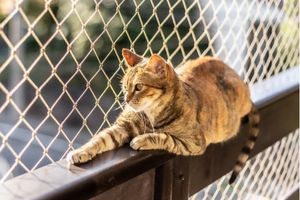Keeping your cat safe at home
In the heart of this town, a charming little house is home to Linda and her beloved feline friend Gus.
Meet Gus the spirited explorer who is always seeking a new adventure.
The world beyond their peaceful home is a place of danger for Gus, filled with busy traffic, fences to climb, neighbouring dogs, snakes and opportunities for mischief.
Gus's curiosity often leads him astray, causing Linda to worry. She knows indoor cats live 10 years longer on average.
Linda doesn't want to be one of the 2 out of 3 owners who lose their cat to an accident, so she begins by securing her yard to prevent Gus from wandering – her mission is to keep Gus safe on all his adventures indoors and out.
For his indoor Kingdom, Gus now has a lofty vantage point where he can watch over his toys and family and climb play and exercise.
Linda is always is finding new things for Gus to learn and enjoy – this keeps the curious explorer in Gus happy and active throughout his long life.
As the sun sets on their little paradise, Linda and Gus know they've found the perfect balance, because even adventurers need a safe home.
Cats have a natural instinct to hunt and to explore the outdoors. However, letting your cat roam freely can be dangerous. This page will explain the benefits of keeping your cat indoors and offer tips to keep them safe and healthy.
Why cats are safer indoors
Letting your cat roam the neighbourhood is extremely dangerous. Surveys show that 2 out of 3 cat owners have permanantly lost a cat to roaming incidents. Outdoor cats can:
- get hit by cars
- be injured in fights
- catch fatal diseases (such as feline AIDS)
- become lost.
Roaming cats can also kill native wildlife — even well-fed cats hunt. Roaming cats can annoy neighbours by:
- spraying
- fighting
- yowling
- digging in gardens.
Legally, you cannot let your cat trespass on other people’s property. If your cat is found wandering off your property and is not identified, they can be seized and impounded. You may have to pay a fine when reclaiming your cat from the council pound.
Some councils also have laws banning cats from certain areas or requiring cats to be kept on their owner’s property during certain hours.
Benefits of keeping your cat indoors
Safety
Being indoors protects your cat from getting lost, injured or killed.
Longer, healthier life
Indoor cats live up 3 times longer than their roaming counterparts and have less exposure to parasites and diseases.
Better reputation for cats
Indoor cats can’t bother neighbours or harm wildlife.
Reduced shelter intake
Fewer roaming cats means fewer strays in shelters and unwanted breeding or cat litters.
Helping your cat adjust to indoor living.
Be patient
Cats can take a while to adjust to staying inside – it might take a month or 2. Adult cats used to roaming outdoors can have more difficulty adjusting. If this is the case, consult your vet for advice. Desexing cats also reduces their desire to roam and helps prevent behavioural problems.
Start slowly
The more slowly you introduce the change, the easier it will be on them. Start by keeping them inside at night and slowly add more indoor time each day.
Good timing
Here are some specific times that might be easier for your cat to adjust:
- When you first bring them home (kitten or adult)
- After moving to a new place (keeps them safe from an unfamiliar place)
- During feeding time (gradually extend the time they spend inside after feeding them indoors)
- During cold weather (they’ll probably want to be warm with you anyway)
Keeping your indoor cat happy
 These are food, warm bedding, a litter box and human interaction.
These are food, warm bedding, a litter box and human interaction.
Provide essentials
Prevent boredom
Offer toys, scratching posts or surfaces and climbing structures to keep your cat stimulated. Learn more about Creating the perfect indoor haven for your cat.
Create a safer outdoor space
Some cat owners may want their indoor cat to also have some outdoor time. Here are some safer options.
Cat enclosures
This is a safe, enclosed outdoor space for your cat to explore. You can buy or build your own enclosure, either freestanding or connected to your house. Escape-proof mesh can used to modify an existing pergola, patio or narrow pathway.
Make sure the enclosure has a cozy sleeping area sheltered from the weather, a scratching post, places for your cat to play, various viewing platforms and separate hiding spots if you have multiple cats.
Ventilation is important if keeping cats in a confined area, especially if you have several cats. Ventilation helps prevent the spread of disease and respiratory problems from a build-up of fumes or stale air.
Refer to our step-by-step DIY instructions with supporting illustrations and photos:
Escape-proof fencing
 This allows your cat more freedom in your backyard but keeps them from roaming the neighbourhood. Escape-proof fencing is ideal for small yards and narrow spaces. You can make existing fencing escape-proof with inward-facing netting or rollers that stops cats from grabbing hold of the top of the fence.
This allows your cat more freedom in your backyard but keeps them from roaming the neighbourhood. Escape-proof fencing is ideal for small yards and narrow spaces. You can make existing fencing escape-proof with inward-facing netting or rollers that stops cats from grabbing hold of the top of the fence.
A wide, smooth metal or plastic collar may need to be placed around tree trucks near the boundary to prevent cats using these trees to escape. The tree collars should be placed at least 2 metres off the ground.
If possible, you can provide access to your house through a cat flap or window for the above options.
Refer to the step-by-step DIY instructions with supporting illustrations and photos:
- Cat-proof fencing (modifying existing fencing to make it ‘cat-proof’, giving your cat free access to all or part of your yard)
Apartment balconies
Use escape-proof netting to create a safe outdoor space. The use of electric containment systems for cats is strictly regulated to protect the welfare of cats.
Supervised walks
If none of the above is possible, short, supervised walks in the backyard are another possible option for cats that don’t automatically try to escape. Some cats can be trained to walk on a harness; however, this is not possible for every cat.
Join the safe cat movement
Many Victorians are already making the responsible choice to keep their cats contained to their property. By joining them, you’re not only keeping your cat safe, but also contributing to a healthier and safer environment for local wildlife.
Make the switch to an indoor lifestyle for your cat. They’ll thank you for it!
Download a printable version of this page: Keeping your cat safe at home ![]() [PDF File - 573.7 KB]
[PDF File - 573.7 KB]